ramonmercado
CyberPunk
- Joined
- Aug 19, 2003
- Messages
- 58,830
- Location
- Eblana
Scythian mummy shown in Germany

The ice had helped to preserve the mummy, scientists say
An international group of archaeologists has shown photos of a well-preserved 2,500-year-old mummy of a Scythian warrior found in Mongolia. The mummy was hailed as a "fabulous find" at a news conference in Berlin.
It was unearthed at a height of 2,600m (8,500ft) in an intact burial mound in the Altai Mountains this summer.
Until now remains of the Scythians - who were Iranian nomadic peoples - had only been found on the Russian side of the Altai, the scientists said.
The mummy was found in the snow-capped mountains by the team of scientists from Germany, Russia and Mongolia.
Presenting the find, the president of the German Archaeological Institute, Hermann Parzinger, said the ice had helped to preserve the mummy.
"We just had to sweep away some dust and could begin," Mr Parzinger said.
Skin on the warrior's upper body was virtually intact, revealing tattoos.
The man - who the archaeologists believe was a noblemen - was dressed in a fur coat and wrapped into sheep's wool lining that was in remarkably good condition.
Two horses with saddles and weapons and also vessels were also found in the burial mound, or kurgan.
The archaeologists say they were placed in the tomb to accompany the warrior into the next life.
The recovered items are currently in storage in Mongolia's capital, Ulan Bator.
http://news.bbc.co.uk/2/hi/europe/5283320.stm
Last edited by a moderator:



